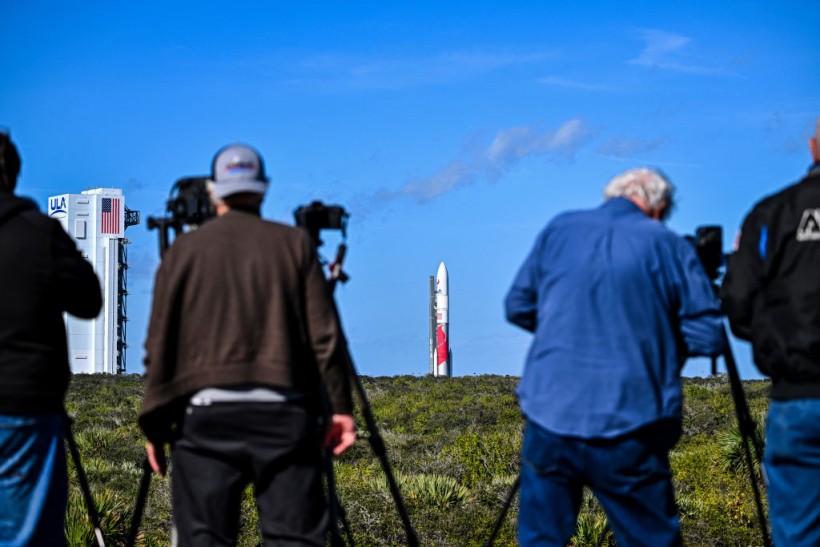Despite NASA's historical prominence in lunar exploration since the Apollo missions, there has been an intriguing absence of lander missions since Apollo 17 in 1972. However, a significant shift is anticipated on Monday afternoon, January 8, as NASA embarks on a return to the lunar surface, this time partnering with a commercial mission.
The collaboration underscores the increasing synergy between NASA and the private space sector, signaling a new era of joint ventures in space exploration.

Members of the media take pictures of the ULA's new rocket Vulcan Centaur carrying Peregrine lunar lander rolls to Space Launch Complex 41 (R) at NASA's Kennedy Space Center in Cape Canaveral, Florida, on January 5, 2024.
Private Venture to Land US Craft on Moon
Preparations are underway at Cape Canaveral in Florida for a historic mission aiming to land a US spacecraft on the moon, a feat not accomplished in over 50 years since the conclusion of the Apollo project.
Named Peregrine Mission One after the fastest animal on Earth, the spacecraft is scheduled to launch at 2:18 am local time (7:18 GMT) on Monday, looping around the Earth before heading to the moon and attempting a landing soon after the local sunrise on February 23.
Despite the inherent risks in space exploration, the mission is considered particularly daring. While NASA has instruments on the robotic lander, this venture is a commercial operation, marking the first time a private company attempts a soft landing on the moon or any celestial body.
Astrobotic's Peregrine lunar lander is NASA's first mission under the Commercial Lunar Payload Services program, contracting American businesses for lunar surface payload transport. However, the launch carries its own risks.
Peregrine will be carried by the untested Vulcan rocket from United Launch Alliance with 20 payloads, including a rover from Carnegie Mellon and unconventional items, such as Wikipedia and cremated remains, the mission stirred controversy.
Navajo Nation President Buu Nygren expressed concerns about the deposition of such material on the sacred moon. Chris Culbert, CLPS program manager, emphasized the commercial nature of the mission, highlighting NASA's limited influence on Astrobotic's payload choices, revealing the intricate blend of scientific and ethical considerations in contemporary lunar exploration.
Peregrine Mission One To Study Ancient Lunar Lava Flow
Peregrine is set for a mission to Sinus Viscositatis, the Bay of Stickiness, an ancient lunar lava flow with unique formations. The spacecraft aims to measure radiation levels, surface and subsurface water ice, the magnetic field, and the lunar exosphere-a tenuous layer of gas.
This data will aid in mitigating risks and utilizing the moon's resources for future human missions. Although acknowledged as a high-risk venture, scientists anticipate insights into lunar water circulation, especially how water molecules are released during the day and trapped at night, using the Peregrine ion-trap mass spectrometer (PITMS) instrument.
Simeon Barber, the lead UK co-investigator on PITMS, recognizes the inherent risks in the mission but underscores the importance of understanding lunar conditions. PITMS will analyze the lunar exosphere's composition, monitoring changes over the lander's operational period.
The spacecraft is the first in a series of lunar landers under NASA's CLPS initiative. Intuitive Machines, based in Houston, is poised to launch the next lander in mid-February, potentially preceding Peregrine's touchdown.
While the surge in commercial lunar interest is welcomed, some scientists, including Prof Katherine Joy, emphasize the need for regulatory frameworks to protect lunar sites of scientific significance amid advancing space exploration and potential future resource extraction endeavors.
RELATED ARTICLE: NASA Released Remastered Images of Apollo 17 Moon Mission on Its 50th Anniversary
Check out more news and information on Moon Landing in Science Times.




![Earth's Quasi-Moon Kamo‘oalewa Could Originate From Lunar Surface Not Asteroid Belt [Study]](https://1721181113.rsc.cdn77.org/data/thumbs/full/53275/89/56/50/40/earths-quasi-moon-kamo-oalewa-could-originate-from-lunar-surface-not-asteroid-belt-study.png)









